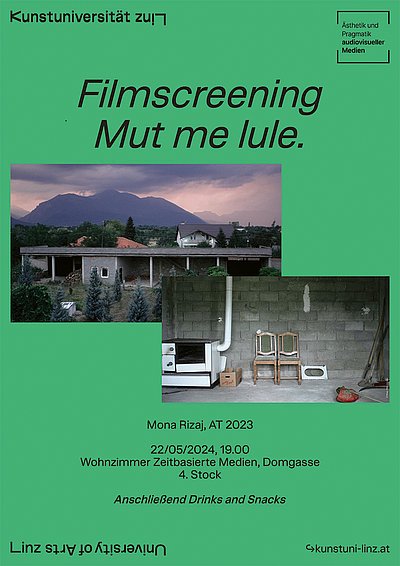Welcome at the Interface Culture program website.
Acting as creative artists and researchers, students learn how to advance the state of the art of current interface technologies and applications. Through interdisciplinary research and team work, they also develop new aspects of interface design including its cultural and social applications. The themes elaborated under the Master's programme in relation to interactive technologies include Interactive Environments, Interactive Art, Ubiquitous Computing, game design, VR and MR environments, Sound Art, Media Art, Web-Art, Software Art, HCI research and interaction design.

The Interface Culture program at the Linz University of Arts Department of Media was founded in 2004 by Christa Sommerer and Laurent Mignonneau. The program teaches students of human-machine interaction to develop innovative interfaces that harness new interface technologies at the confluence of art, research, application and design, and to investigate the cultural and social possibilities of implementing them.
The term "interface" is omnipresent nowadays. Basically, it describes an intersection or linkage between different computer systems that makes use of hardware components and software programs to enable the exchange and transmission of digital information via communications protocols.
However, an interface also describes the hook-up between human and machine, whereby the human qua user undertakes interaction as a means of operating and influencing the software and hardware components of a digital system. An interface thus enables human beings to communicate with digital technologies as well as to generate, receive and exchange data. Examples of interfaces in very widespread use are the mouse-keyboard interface and graphical user interfaces (i.e. desktop metaphors). In recent years, though, we have witnessed rapid developments in the direction of more intuitive and more seamless interface designs; the fields of research that have emerged include ubiquitous computing, intelligent environments, tangible user interfaces, auditory interfaces, VR-based and MR-based interaction, multi-modal interaction (camera-based interaction, voice-driven interaction, gesture-based interaction), robotic interfaces, natural interfaces and artistic and metaphoric interfaces.
Artists in the field of interactive art have been conducting research on human-machine interaction for a number of years now. By means of artistic, intuitive, conceptual, social and critical forms of interaction design, they have shown how digital processes can become essential elements of the artistic process.
Ars Electronica and in particular the Prix Ars Electronica's Interactive Art category launched in 1991 has had a powerful impact on this dialog and played an active role in promoting ongoing development in this field of research.
The Interface Cultures program is based upon this know-how. It is an artistic-scientific course of study to give budding media artists and media theoreticians solid training in creative and innovative interface design. Artistic design in these areas includes interactive art, netart, software art, robotic art, soundart, noiseart, games & storytelling and mobile art, as well as new hybrid fields like genetic art, bioart, spaceart and nanoart.
It is precisely this combination of technical know-how, interdisciplinary research and a creative artistic-scientific approach to a task that makes it possible to develop new, creative interfaces that engender progressive and innovative artistic-creative applications for media art, media design, media research and communication.
Mut me lule.
22. Mai 2024, 19.00 Uhr Kunstuniversität Linz Domgasse 1, Wohnzimmer Zeitbasierte Medien, 4.OG
Medienkultur- und Kunsttheorien sowie Ästhetik und Pragmatik audiovisueller Medien laden ganz herzlich zum Filmscreening "Mut me lule" von Mona Rizaj ein.
Mona ist derzeit die Studienkoordinatorin von MKKT / Medienkultur- und Kunsttheorien.
Wir freuen uns daher, wenn viele Studierende und Lehrende diese Gelegenheit für ein Come Together nutzen.
Zum Film:
Zwei Stimmen, Sprachen, Landschaften greifen ineinander, sprechen zusammen und aneinander vorbei. Gärten, Weinkeller, Ackerflächen und Wohnzimmeransichten, Erzählungen und Widerstände. Verklärungen und Projektionen auf das Andere; das Weggehen, das Bleiben, das Wiederkommen. Erinnerungen an Kennenlernen, an Begegnungen, an ein Paar, die Kinder und die Eltern. Das Gewesene, das Festgehaltene und das beiläufig Verlorene. Die Dinge waren, wie sie waren. Dazwischen, im Unausgesprochenen, in den Widersprüchen, werden Leben und Räume in Gleichzeitigkeit und Differenz erfahrbar. Räumliche Distanzen und Deklinationen von Alltag. In der dritten Generation wird das Davor oft erstmals fassbar. Die Anordnung im filmischen Raum lässt erahnen, was es bedeuten kann, Spuren von all diesen Orten in sich eingeschrieben zu wissen. (Djamila Grandits, diagonale 2024)
Mona Rizaj, geboren in Wien, studierte Bildende Kunst mit Schwerpunkt Zeitbezogene Medien in Hamburg. Sie lebt und arbeitet in Wien und Linz. Sie ist Teil der Experimentellen Klasse, einem Kollektiv, das an der Schnittstelle von bildender Kunst und Theorie arbeitet und sich auf queere, feministische und intersektionale Themen und Arbeitsweisen konzentriert. In ihrer künstlerischen Arbeit beschäftigt sie sich mit der kosovo-albanischen Diaspora und dem Zuhören als Methode.
